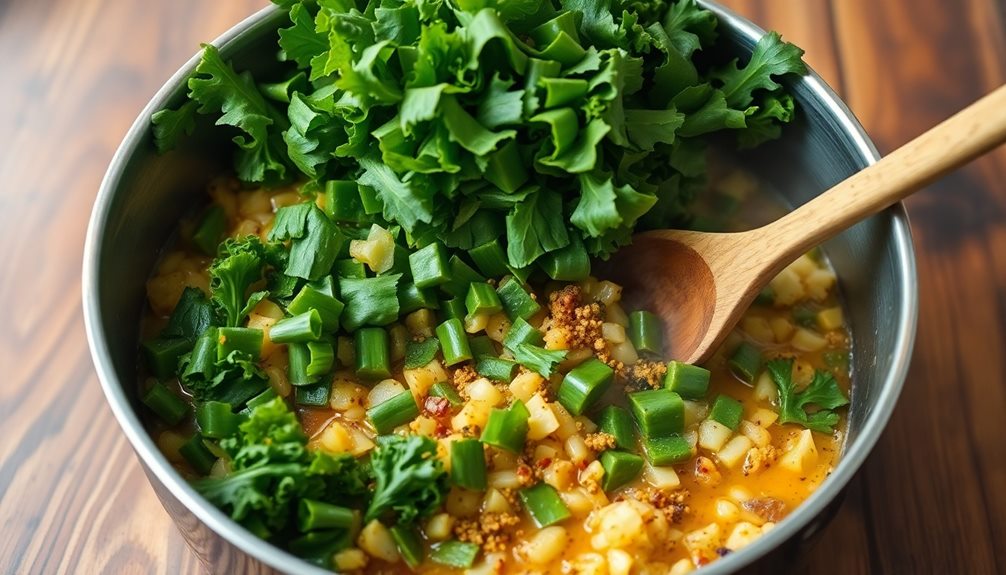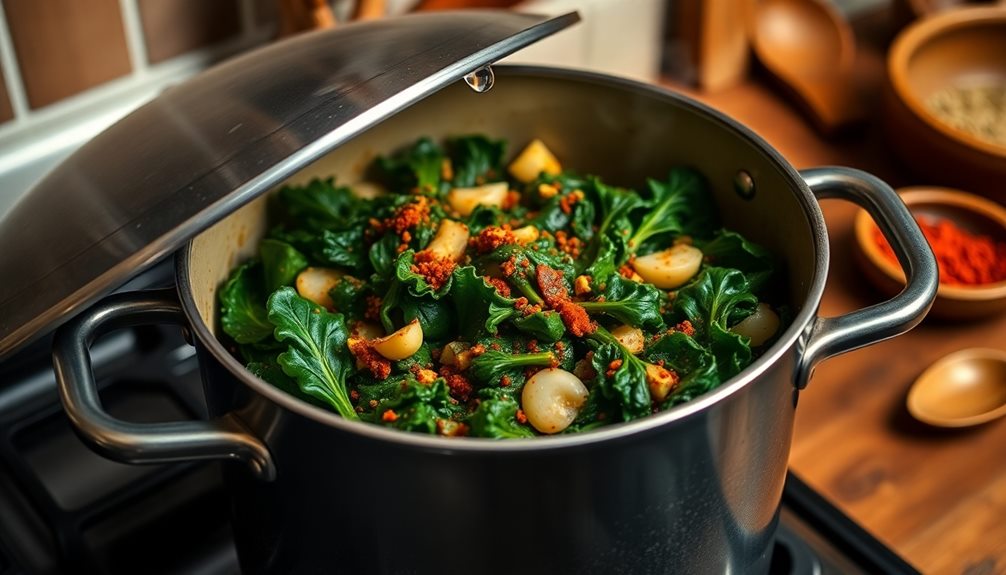You're gonna love making Ethiopian kale, or "gomen"! Start by washing and chopping fresh kale into bite-sized pieces. Sauté chopped onions in olive oil until they're soft, then add minced garlic and your favorite spices like cumin and turmeric for a flavorful punch. Stir in the kale until it wilts, then cover it and steam for a few minutes. This nutritious dish is packed with vitamins and pairs perfectly with rice or lentils. It's not just healthy, but also a wonderful way to bring family and friends together! Ready to explore more delicious ways to enjoy this vibrant dish?
Key Takeaways
- Ethiopian kale, or "gomen," is rich in vitamins A, C, and K, making it a highly nutritious side dish.
- The recipe emphasizes sautéing and steaming, preserving kale's flavor and nutrients while achieving tender texture.
- Key ingredients include fresh kale, onions, garlic, and spices like cumin and turmeric for enhanced flavor.
- This dish pairs well with grains like injera or rice and proteins such as lentils or chicken.
- Sharing this recipe fosters community connections and celebrates the rich culinary traditions of Ethiopia.
History
When you explore the history of Ethiopian kale, you'll discover that this leafy green has been a staple in Ethiopian cuisine for centuries. Known as "gomen," it's not just a vegetable; it's a part of family gatherings and celebrations. People in Ethiopia have been enjoying gomen for generations, making it a beloved dish that connects them to their roots.
Ethiopian kale grows well in the highlands of the country, where the cool climate helps it flourish. Farmers have cultivated it for its nutritional value, rich flavor, and versatility. It's packed with vitamins and minerals, making it a healthy choice for everyone.
Traditionally, it's often cooked with spices, garlic, and onions, bringing out its natural taste and making it a delicious side dish.
As you delve deeper into its history, you'll find that gomen is more than just food; it represents community and togetherness. Families often gather around a big plate of injera topped with gomen, sharing stories and laughter.
Cooking Steps
To make a delicious Ethiopian kale dish, start by preparing your ingredients. Gather fresh kale, a chopped onion, minced garlic, and some spices like turmeric and cumin. You'll also need a bit of olive oil for cooking.
Now, heat the olive oil in a large skillet over medium heat. Add the chopped onion and sauté it for about five minutes, or until it turns soft and golden.
Then, toss in the minced garlic, stirring for another minute. The aroma will be amazing!
Next, add the kale to the skillet. Stir it well, and let it cook down for about five to seven minutes.
As the kale wilts, sprinkle in the turmeric and cumin. These spices will give your dish that yummy Ethiopian flavor.
Keep stirring until the kale is tender and bright green.
Step 1. Wash and Chop Kale

Before you dive into cooking, you'll want to thoroughly wash and chop the kale. Start by rinsing the kale under cold water to remove any dirt or tiny bugs. Gently rub the leaves with your hands to make sure they're nice and clean.
Once you're done washing, shake off the excess water. You can also use a salad spinner if you have one, which makes drying the kale super easy!
Now, it's time to chop! Lay the kale leaves flat on a cutting board. Grab a sharp knife and remove the tough stems by cutting along each side. Don't worry if you're not perfect; just try to keep the leaves intact.
After removing the stems, stack a few leaves together, and slice them into bite-sized pieces. Aim for pieces about one to two inches long—this makes them easier to cook and eat.
Once you've chopped all the kale, look at that beautiful green pile! You're one step closer to creating a delicious Ethiopian dish. Isn't it exciting?
With your kale all prepped, you're ready to move on to the next cooking steps!
Step 2. Sauté Onions Until Translucent

Start by heating a tablespoon of oil in a large skillet over medium heat. As the oil warms, take a moment to enjoy the sizzle you'll soon hear.
Next, slice one medium onion into thin rings or half-moons. Once the oil is hot, carefully add the onions to the skillet. You'll want to stir them gently, making sure they get coated in the oil.
Cook the onions for about five to seven minutes, stirring occasionally. Keep an eye on them, as they'll start to soften and change color. You're looking for that lovely, translucent look, which means they're perfectly cooked! If the heat feels too high, don't hesitate to lower it a bit. We want those onions to become sweet and flavorful, not burnt.
As the onions sauté, they'll fill your kitchen with a warm, inviting aroma. It's a sign that you're on the right track!
Once the onions are translucent, you're ready to move on to the next step. This is just the beginning of creating a delicious Ethiopian kale dish that everyone will love! Enjoy the process—it's all part of the fun!
Step 3. Add Garlic and Spices

With the onions now perfectly translucent, it's time to elevate the flavor by adding garlic and spices. Grab some minced garlic—about three cloves should do the trick. When you toss it into the pan, you'll notice the delightful aroma filling your kitchen. Stir the garlic around for about a minute, just until it turns golden. Be careful not to let it burn!
Chia seeds, which are high in omega-3 fatty acids and rich in dietary fiber, are a fantastic addition to your meals for enhancing digestive health.
Now, let's spice things up! You can't go wrong with a teaspoon of ground cumin and a half teaspoon of turmeric. These spices are like a warm hug for your taste buds! Sprinkle them in, and stir everything together. The colors will become vibrant, and the smell will make your mouth water.
If you want a little kick, consider adding a pinch of cayenne pepper. Just a little bit goes a long way! Stir everything well, letting the spices coat the onions and garlic. This step is super important because it brings out all those wonderful flavors.
Once you're happy with the aroma, you're ready for the next step! Your dish is already smelling amazing, and it's only going to get better from here!
Step 4. Add Kale and Stir Well

Now that the spices have melded beautifully with the garlic and onions, it's time to introduce the kale. Grab a bunch of fresh, vibrant kale and wash it thoroughly. Once it's clean, tear the leaves into bite-sized pieces. This will make it easier to eat later.
Add the kale to your pan, and watch it transform as it mixes with the delightful flavors already cooking.
Stir well! You want each piece of kale to get coated in that spicy, garlicky goodness. As you stir, the kale will start to wilt and become tender. This is where the magic happens! The bright green leaves will soak up all those delicious flavors, making each bite a treat.
Keep stirring for a few minutes, and don't forget to scrape the bottom of the pan so nothing burns.
You might notice that the kale shrinks a bit, and that's just fine. It'll still pack a nutritious punch! Once the kale is bright and tender, you'll be ready for the next step in this exciting recipe.
Just think about how tasty this dish is going to be—your taste buds are in for a real treat!
Step 5. Cover and Steam Kale

Covering the kale is essential for the steaming process, which locks in moisture and enhances the flavors. Once you've added the kale to your pot, grab a lid and put it on top. This helps create a mini sauna for your kale, allowing it to cook just right!
Turn the heat to medium-low and let it steam for about 5 to 7 minutes. You'll notice the vibrant green color deepening, and that's a sign it's getting tender and delicious. During this time, try not to peek too often; letting steam escape can make it take longer to cook.
When the timer goes off, carefully remove the lid—watch out for steam! Give the kale a gentle stir to mix in all those lovely flavors. You can even taste it to see if it's to your liking. If you want it a bit softer, cover and steam for a couple more minutes.
Once you're happy with the texture, it's ready to serve. This Ethiopian kale dish is full of goodness and pairs well with many meals. Enjoy every bite of your tasty creation!
Final Thoughts
As you reflect on this Ethiopian kale recipe, you'll find that it's not just a delicious dish but also a celebration of vibrant flavors and healthy eating.
You've learned how to make tender, flavorful kale that's packed with nutrients. This dish is perfect for sharing with family and friends, showing off the rich culture of Ethiopian cuisine.
By adding spices like garlic and ginger, you've transformed simple kale into a dish that dances on your taste buds. It's amazing how a few ingredients can come together to create something so special!
You can feel proud knowing that you're serving something not only tasty but also good for you.
Next time you prepare this dish, consider pairing it with your favorite grains or proteins to make a complete meal.
Don't forget to share your experience with others—who knows, you might inspire someone else to try cooking Ethiopian food!
Frequently Asked Questions
What Are the Health Benefits of Ethiopian Kale?
Ethiopian kale's packed with vitamins A, C, and K, boosting your immune system and promoting healthy skin. It also offers fiber, aiding digestion, and antioxidants, which help protect your cells from damage. Enjoy its numerous benefits!
Can I Use Other Greens Instead of Kale?
Absolutely, you can use other greens instead of kale! Spinach, Swiss chard, or collard greens work great. Just adjust the cooking time and seasonings to suit the greens you choose for a delicious result.
How Do I Store Leftover Ethiopian Kale?
To store leftover kale, cool it to room temperature, then transfer it to an airtight container. Refrigerate for up to five days. If you want to freeze it, use freezer bags for longer storage.
Is Ethiopian Kale Suitable for Vegan Diets?
Yes, Ethiopian kale's perfect for vegan diets. It's packed with nutrients and flavor, making it a great choice. You'll enjoy its versatility in various dishes, ensuring you maintain a healthy, plant-based lifestyle effortlessly.
What Dishes Pair Well With Ethiopian Kale?
When you're pairing dishes, Ethiopian kale complements spicy lentil stew, injera, or roasted vegetables beautifully. You'll find its earthy flavor enhances the meal, making it a perfect addition to any Ethiopian-inspired spread.









